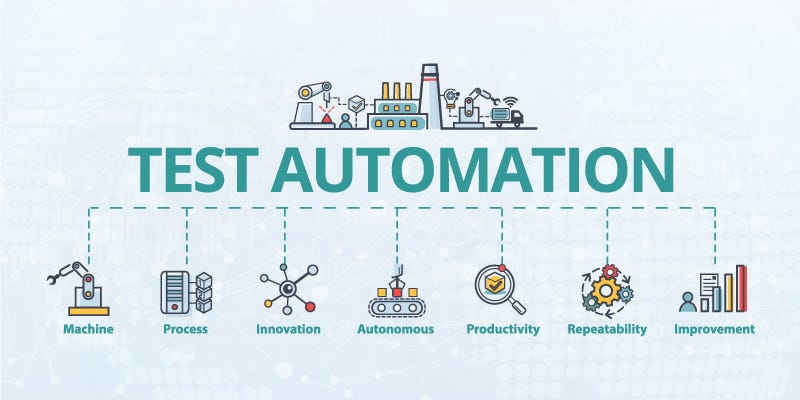The Significance of Automation Testing in Agile Development Settings
From Manual to Automated Screening: A Comprehensive Guide to Transitioning Smoothly and Effectively
In the realm of software program screening, the change from handbook to automated processes has ended up being a significantly essential shift for companies seeking to enhance performance and accuracy in their screening practices. As modern technology remains to development, the need for smooth and reliable automatic screening techniques has never been a lot more pressing. The trip from guidebook to automated screening is not without its obstacles, however when approached purposefully and with a clear plan in mind, the benefits can be considerable - automation testing. In this detailed guide, we will discover key steps and considerations important for a successful change, from the initial selection of devices to the assimilation of automation into existing process. Remain tuned to reveal the insights that will certainly assist lead the means for a smoother and extra effective testing process.
Benefits of Automated Examining
Automated screening supplies numerous advantages, boosting performance and precision in software growth processes. One primary advantage is the substantial decrease in screening time. Automated examinations can be run at the same time on multiple devices and running systems, considerably accelerating the testing stage contrasted to hands-on testing. This boosted performance permits faster feedback on the top quality of the software program, allowing developers to recognize and address problems immediately.
Additionally, automated screening makes certain a greater level of precision in identifying issues. Since automated examinations adhere to predefined manuscripts, human mistake is decreased, bring about more reliable test outcomes. Uniformity in screening is additionally boosted, as automated examinations implement the very same steps precisely each time they are run. This uniformity is crucial in making certain that all functionalities of the software are completely tested, lowering the likelihood of undiscovered bugs slipping with to manufacturing.
Choosing the Right Tools

Firstly, examine your objectives and needs. Comprehend the scope of your project, the modern technologies entailed, and the ability of your group. This evaluation will certainly aid you identify the functions and capacities you call for in your testing tools.
Secondly, think about the compatibility of the devices with your existing procedures and systems. Seamless integration with your existing software application growth lifecycle is vital to make certain a smooth change to automation.
Furthermore, review the scalability and versatility of the tools. As your screening needs evolve, the tools should have the ability to adapt and suit adjustments successfully.
Lastly, factor in the assistance and area around the devices. When implementing automated screening, durable support and an active customer area can provide valuable resources and help. By very like this carefully taking into consideration these aspects, you can choose the right devices that line up with your requirements and established the stage for an effective transition to automated screening.
Writing Efficient Test Manuscripts

When crafting test scripts, it is vital to take into consideration the details requirements of the software being tested and guarantee that the manuscripts address all critical functionalities. Descriptive and clear naming conventions for examination manuscripts and examination cases can improve readability and maintainability. In addition, including error handling devices within the test scripts can assist in recognizing and dealing with issues quickly.
In addition, arranging test manuscripts right into modular parts can improve reusability and scalability, reducing redundancy and enhancing efficiency in test manuscript upkeep. Regular evaluations and updates to check scripts are essential to equal advancing software requirements and capabilities. By adhering to these principles, testers can create durable and reliable examination scripts that add considerably to the success of automated testing procedures.
Integrating Automation Into Workflows
By effortlessly incorporating automated screening tools like Selenium or Appium right into the software program development lifecycle, groups can attain faster comments on code modifications, leading to quicker bug detection and resolution. This assimilation enables for constant testing throughout the growth process, making go to the website sure that any type of issues are identified early on, resulting in higher software program high quality. Correct integration of automation devices needs cooperation between advancement, screening, and operations teams to develop a unified process that optimizes effectiveness and efficiency in delivering top notch software program products.
Guaranteeing a Smooth Transition
Effectively transitioning to automated screening includes meticulous preparation and careful implementation to minimize interruptions and maximize performance in the software advancement process - automation testing. To ensure a smooth change, it is vital to begin by performing an extensive evaluation of the existing testing processes and recognizing locations where automation can bring one of the most significant benefits. Engaging with all stakeholders at an early stage at the same time, consisting of designers, testers, and project supervisors, is vital for gathering assistance and buy-in for the automation effort
Interaction is key throughout this shift phase. Clear communication of the objectives, benefits, and expectations of automated screening assists to handle any resistance or worries that might emerge. Furthermore, offering ample training and resources for employee to upskill in automation devices and strategies is crucial for making certain an effective shift.

Final Thought
In conclusion, transitioning from guidebook to automated testing supplies countless benefits, consisting of raised effectiveness and integrity. By picking the appropriate tools, creating reliable examination scripts, and integrating automation flawlessly right into workflows, organizations can guarantee a smooth and effective transition. It is vital to welcome automation as a valuable asset in software screening procedures to improve total top quality and performance.
In the realm of software application testing, the shift from manual to automated processes has actually come to be a progressively essential change for organizations seeking to enhance performance and precision in their testing methods. Automated examinations can be run simultaneously on numerous gadgets and operating systems, drastically speeding up the testing stage contrasted to manual screening. Uniformity in testing is additionally improved, as automated tests implement the exact same actions specifically each time they are run.To make sure the effective application of selected screening devices, the production of effective examination manuscripts plays a crucial function in verifying the capability and efficiency of automated procedures - automation testing. By adhering to these principles, testers can develop durable and reliable test manuscripts that contribute considerably to the success of automated screening processes